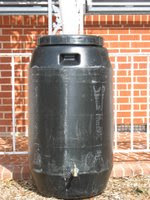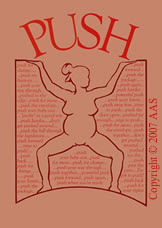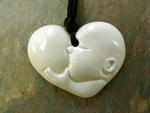EXCLUSIVE INTERVIEW: Mum forced into home birth after floods cut off road
Thursday, February 12, 2009, 08:22
WATER baby Charlie Beattie made a memorable arrival into the world when floods meant his mum could not make it to hospital for his birth.
Debbie Beattie went into labour on Tuesday morning, but she and husband Russell, along with three-year-old daughter Lauren, found the roads out from their home in Rayne were blocked by floods and they could not get to William Julien Courtauld Hospital (WJC) in Braintree.
They had to turn back home and two emergency care practitioners, Steve Colmer and Steve Monk, from the ambulance service, who had fought their way through the flood water, made it there just in time to deliver Charlie.
He was born at four minutes past eight and weighed in at a healthy 8lb 13oz.
Proud dad Russell said: "We set out at 7.30 in the morning and found that the road from Rayne to Braintree was about 4ft under water and the alternative route out of the village had flood water 2ft deep.
Continue at UK Mum forced to do homebirth because of flooding
This and many other new reports continue to fuel my concerns for pregnant and birthing women and babies who will inevitably be caught up in situations that do not allow them access to the hospital, and/or in many states, including Missouri, ACCESS to a midwife. As the Columbia, MO community prepared for disaster possibilities, I was at a forum in June of 2007 and repeatedly asked every representative from the mult-organization team about the plight of women in MO. At that time, it was a felony for a midwife to practice in MO. All women in MO did not have the option to choose midwifery, and this meant that many women in the rural areas (most of MO) were forced to accept the choice of driving hours to give birth.
At this meeting, all day long, I continued to asked the representatives of the Red Cross, the Fire District, the city, all the members of the diaster readiness teams,
"What about the pregnant and birthing women, and women with infants?"
"What if the hospital is unable to accept patients because it is destroyed, or quaranteened?"
"What if a laboring woman can not make it to the hospital? This happens now in an ice or snow storm now?"
And, I point out that in other industrialized nations, including the UK, midwives work WITH doctors and nurses in partnership. Their government and hospitals accept and promote midwifery care. There, a woman has a societial learning and knowing that birth outside of a hospital without a doctor anywhere near by is doable and even preferrable. So, when a diaster happens she IS ABLE to do it without the ingrained fears and beliefs that American women have. But, my question, "What are you doing in this area?" receives only uhmms, ahhhh, or "that is question for so-and-so who is on next panel."
All day long people just looked at me, some dumbfounded, some annoyed ... Midwifery was still illegal at that time and the social and political battleground was very bloody at that time. The only possible options given were that emergency workers or medical staff would have to be called. MY QUESTION, "Is this being considered -- is a plan for pregnant and laboring and birthing women being developed?'
"Ahhhh, uhhhmmm."
For some very strange reason, the dire needs of the pregnant, laboring and birthing woman and her baby during a disaster have not even been considered. I blows me away everytime I think about it, and everytime I think about that day of asking different people, experts in preparing for disaster and protecting us, about pregnant and birthing women and babies needs during a diaster. I am sure it is the same in most places. Every community, big and small, needs an elaborate system in place to care for these most vulnerable of people in a diaster. Is there a "committee" just to look at this need -- from another perspective OTHER than the medical perspective and what they can do and need? Is there a plan in place, with a team on board, of midwives, doulas, and nurses and doctors who will GO TO the woman? Why is this not a high agenda for the Red Cross?
HOMEFIRST in Chicago is a good model to begin to see what is needed.
For the Safe Baby Resolution, which I co-wrote with Star Newland and was introduced in Hawaii Legislature in 2007, I wrote a broad document of questions for legislators everywhere:
Legislative Research Study Questions
by Janel Martin-Miranda, MA, LPC,
The Safe Baby Resolution team asks our state legislators to form a Safe Baby Commission to be comprised of representatives from birthing women, doulas, midwives, physicians, therapists, psychologists, teachers, clergy, attorneys, representatives from women’s and children’s group (i.e., Shaken Baby, Domestic Violence, March of Dimes, Drug Prevention) and a legislative liaison to consider how to answer the following questions.
We are asking the state legislators to assign the commission (or appropriate department, such as Maternal Health and Child Wellness) with the objectives:
- Gather and study the current science that supports the resolution,
- Facilitate multi-disciplinary collaboration,
- Determine the feasibility of launching a major research project to look for long-term solutions, and
- Report the findings of the resolution study at the next legislative session
Number Five addresses homeland diaster preparedness and need to provide for pregnant and laboring women:
5. Homeland Disaster Preparedness – Include a plan for Pregnant, Laboring and Birthing Women, and Infants. How is the Missouri Home Land Security disaster plan prepared to care for pregnant and birthing women in MO in the event of a disaster? Currently, the practice of direct-entry midwifery is against the law in MO, and the CNM must be backed by a physician; therefore, out-of-hospital birth is rare and socially feared. In the event of a disaster hospitals will be focused on trauma patients and/or may be quarantined, and there will be zero options in Missouri for safe and quality care for pregnant and birthing women and babies outside of the hospital. What will they do?
I hope every community will look at this and make provisions for the most vulnerable during a disaster -- pregnant women and laboring and birthing women and babies. I find it interesting in the stories coming out of the recent weather and bridge situation in UK. When a woman can not get to the hospital there is not a collective panic. Women there know they can give birth outside of a hospital.
What what about this stupid, "Shoe lace" thing to tie off the cord? One report was father was struggling to get his shoe lace off!?!? As I prepare the research and father's voices for my film, I am just appalled ... WHY IS THE MEDICAL COMMUNITY STILL PROMOTING THIS!?!? The baby needs to stay attached to the mother. The BABY NEEDS his or her CORD BLOOD. The mother's body and the PLACENTA ARE the RESUSCITATOR. The BABY's physiology WORKS and will clamp the cord. THE FATHER NEEDS TO BE CONNECTING WITH HIS BABY, NOT SEPARATING him or her PREMATURELY from the mother. There is NO MEDICAL REASON to clamp the cord! #*$ &$& )$)__$&#^$*
From the UK article:
"We stayed at the scene for a couple of hours and worked together with the midwife to carry out full health checks, making sure both mum and baby were stable.
"Fortunately they didn't need to go to hospital and the family, including the proud older sister, were able to stay at home, allowing the new addition to settle in comfortably."
NOTE the MENTAL and EMOTIONAL difference? NO way in H-ll, would that happen in America -- leaving the mother and baby in the sanctity of their own home, after being assessed by the medical team on site. In America NO ONE can be born with out the interrogation of the multiple teams of nurses and doctors. Don't we all know the babies who were born at home only to be whisked away for hours and days of intrusive, violating, painful "tests" by strangers and separation from mother?
Now, that I've blown off some steam, back to work on the film ....
The Other Side of the Glass
Part One was officially released June 2013 in digital distribution format.
To purchase to to www.theothersideoftheglass.com
If you were a donor and want to download your copy send an email to theothersideoftheglassfilm@gmail.com.
The trailer
Thursday, February 12, 2009
Women and Babies in a Disaster Situation
Subscribe to:
Post Comments (Atom)
"Soft is the heart of a child. Do not harden it."
A public awareness reminder that things that happen behind the scenes, out of our sight, aren't always as rosy as we might think them to be. Perhaps its a restaurant cook who accidentally drops your burger
on the floor before placing it on the bun and serving it to you. Here it's an overworked apathetic (pathetic) nurse giving my newborn daughter her first bath.
Please comment and rate this video, so as to insure that it is viewed as widely as possible, perhaps to prevent other such abuse. -- The mother who posted this YouTube. How NOT to wash a baby on YouTube
Are you going to try to tell me that "babies don't remember?" There is no difference to this baby's experience and the imprinting of her nervous system/brain and one that is held and cleaned by the mother or father either at the hospital or at home?
By the way, this is probably NOT the baby's first bath. The nurse is ungloved. Medical staff protocol is that they can't handle a baby ungloved until is has been bathed (scrubbed if you've seen it) because the baby is a BIO-HAZARD -- for them. Never mind that the bio-hazard IS the baby's first line of defense against hospital germs.
Missouri Senator Louden Speaks
Finally, A Birth Film for Fathers
Part One of the "The Other Side of the Glass: Finally, A Birth Film for and about Men" was released June, 2013.
Through presentation of the current research and stories of fathers, the routine use of interventions are questioned. How we protect and support the physiological need of the human newborn attachment sequence is the foundation for creating safe birth wherever birth happens.
Based on knowing that babies are sentient beings and the experience of birth is remembered in the body, mind, and soul, fathers are asked to research for themselves what is best for their partner and baby and to prepare to protect their baby.
The film is designed for midwives, doulas, and couples, particularly fathers to work with their caregivers. Doctors and nurses in the medical environment are asked to "be kind" to the laboring, birthing baby, and newborn. They are called to be accountable for doing what science has been so clear about for decades. The mother-baby relationship is core for life. Doctors and nurses and hospital caregivers and administrators are asked to create protocols that protect the mother-baby relationship.
Men are asked to join together to address the vagaries of the medical system that harm their partner, baby and self in the process of the most defining moments of their lives. Men are asked to begin to challenge the system BEFORE they even conceive babies as there is no way to be assured of being able to protect his loved ones once they are in the medical machine, the war zone, on the conveyor belt -- some of the ways that men describe their journey into fatherhood in the medicine culture.
Donors can email theothersideoftheglassfilm@gmail.com to get a digital copy.
Through presentation of the current research and stories of fathers, the routine use of interventions are questioned. How we protect and support the physiological need of the human newborn attachment sequence is the foundation for creating safe birth wherever birth happens.
Based on knowing that babies are sentient beings and the experience of birth is remembered in the body, mind, and soul, fathers are asked to research for themselves what is best for their partner and baby and to prepare to protect their baby.
The film is designed for midwives, doulas, and couples, particularly fathers to work with their caregivers. Doctors and nurses in the medical environment are asked to "be kind" to the laboring, birthing baby, and newborn. They are called to be accountable for doing what science has been so clear about for decades. The mother-baby relationship is core for life. Doctors and nurses and hospital caregivers and administrators are asked to create protocols that protect the mother-baby relationship.
Men are asked to join together to address the vagaries of the medical system that harm their partner, baby and self in the process of the most defining moments of their lives. Men are asked to begin to challenge the system BEFORE they even conceive babies as there is no way to be assured of being able to protect his loved ones once they are in the medical machine, the war zone, on the conveyor belt -- some of the ways that men describe their journey into fatherhood in the medicine culture.
Donors can email theothersideoftheglassfilm@gmail.com to get a digital copy.
Buy the film at www.theothersideoftheglass.com.
The film focuses on the male baby, his journey from the womb to the world and reveals healing and integrating the mother, father, and baby's wounded birth experience. The film is about the restoring of our families, society, and world through birthing loved, protected, and nurtured males (and females, of course). It's about empowering males to support the females to birth humanity safely, lovingly, and consciously.
Finally, a birth film for fathers.
The film focuses on the male baby, his journey from the womb to the world and reveals healing and integrating the mother, father, and baby's wounded birth experience. The film is about the restoring of our families, society, and world through birthing loved, protected, and nurtured males (and females, of course). It's about empowering males to support the females to birth humanity safely, lovingly, and consciously.
Finally, a birth film for fathers.
What People Are Saying About the FIlm
Well, I finally had a chance to check out the trailer and .. wow! It's nice that they're acknowledging the father has more than just cursory rights (of course mom's rights are rarely acknowledged either) and it's great that they're bringing out the impact of the experience on the newborn, but I'm really impressed that they're not shying away from the political side.
They are rightly calling what happens in every American maternity unit, every day, by its rightful name - abuse. Abuse of the newborn, abuse of the parents and their rights, abuse of the supposedly sacrosanct ethical principal of patient autonomy and the medico-legal doctrine of informed consent, which has been long ago discarded in all but name. I love it!
In the immortal words of the "shrub", "bring it on!" This film needs to be shown and if I can help facilitate or promote it, let me know.
Father in Asheville, NC
Thanks for sharing this. It was very touching to me. I thought of my brother-in-law standing on the other side of the glass when my sister had to have a C-section with her first child because the doctor was missing his golf date. I'll never forget his pacing back and forth and my realizing that he was already a father, even though he hadn't been allowed to be with his son yet.
Margaret, Columbia, MO
They are rightly calling what happens in every American maternity unit, every day, by its rightful name - abuse. Abuse of the newborn, abuse of the parents and their rights, abuse of the supposedly sacrosanct ethical principal of patient autonomy and the medico-legal doctrine of informed consent, which has been long ago discarded in all but name. I love it!
In the immortal words of the "shrub", "bring it on!" This film needs to be shown and if I can help facilitate or promote it, let me know.
Father in Asheville, NC
OMG'ess, I just saw the trailer and am in tears. This is so needed. I watch over and over and over as fathers get swallowed in the fear of hospitals birth practice. I need a tool like this to help fathers see how very vital it is for them to protect their partner and baby. I am torn apart every time I see a father stand back and chew his knuckle while his wife is essentially assaulted or his baby is left to lie there screaming.
Please send me more info!!!!
Carrie Hankins
CD(DONA), CCCE, Aspiring Midwife
720-936-3609
Thanks for sharing this. It was very touching to me. I thought of my brother-in-law standing on the other side of the glass when my sister had to have a C-section with her first child because the doctor was missing his golf date. I'll never forget his pacing back and forth and my realizing that he was already a father, even though he hadn't been allowed to be with his son yet.
Margaret, Columbia, MO
In case you don't find me here
Soon, I'll be back to heavy-duty editing and it will be quiet here again. I keep thinking this blog is winding down, and then it revives. It is so important to me.
I wish I'd kept a blog of my journey with this film this past 10 months. It's been amazing.
I have a new blog address for the film, and will keep a journal of simple reporting of the journey for the rest of the film.
www.theothersideoftheglassthefilm.blogspot.com
I'll be heading east this week to meet with a group of men. I plan to post pictures and clips on the film blog.
I'll keep up here when I can -- when I learn something juicy, outrageous, or inspiring related to making birth safer for the birthing baby.
I wish I'd kept a blog of my journey with this film this past 10 months. It's been amazing.
I have a new blog address for the film, and will keep a journal of simple reporting of the journey for the rest of the film.
www.theothersideoftheglassthefilm.blogspot.com
I'll be heading east this week to meet with a group of men. I plan to post pictures and clips on the film blog.
I'll keep up here when I can -- when I learn something juicy, outrageous, or inspiring related to making birth safer for the birthing baby.
Review of the film
Most of us were born surrounded by people who had no clue about how aware and feeling we were. This trailer triggers a lot of emotions for people if they have not considered the baby's needs and were not considered as a baby. Most of us born in the US were not. The final film will include detailed and profound information about the science-based, cutting-edge therapies for healing birth trauma.
The full film will have the interviews of a wider spectrum of professionals and fathers, and will include a third birth, at home, where the caregivers do a necessary intervention, suctioning, while being conscious of the baby.
The final version will feature OBs, RNs, CNMs, LM, CPM, Doulas, childbirth educators, pre and perinatal psychologists and trauma healing therapists, physiologists, neurologists, speech therapists and lots and lots of fathers -- will hopefully be done in early 2009.
The final version will include the science needed to advocated for delayed cord clamping, and the science that shows when a baby needs to be suctioned and addresses other interventions. Experts in conscious parenting will teach how to be present with a sentient newborn in a conscious, gentle way -- especially when administering life-saving techniques.
The goal is to keep the baby in the mother's arms so that the baby gets all of his or her placental blood and to avoid unnecessary, violating, and abusive touch and interactions. When we do that, whether at home or hospital, with doctor or midwife, the birth is safe for the father. The "trick" for birthing men and women is how to make it happen in the hospital.
The full film will have the interviews of a wider spectrum of professionals and fathers, and will include a third birth, at home, where the caregivers do a necessary intervention, suctioning, while being conscious of the baby.
The final version will feature OBs, RNs, CNMs, LM, CPM, Doulas, childbirth educators, pre and perinatal psychologists and trauma healing therapists, physiologists, neurologists, speech therapists and lots and lots of fathers -- will hopefully be done in early 2009.
The final version will include the science needed to advocated for delayed cord clamping, and the science that shows when a baby needs to be suctioned and addresses other interventions. Experts in conscious parenting will teach how to be present with a sentient newborn in a conscious, gentle way -- especially when administering life-saving techniques.
The goal is to keep the baby in the mother's arms so that the baby gets all of his or her placental blood and to avoid unnecessary, violating, and abusive touch and interactions. When we do that, whether at home or hospital, with doctor or midwife, the birth is safe for the father. The "trick" for birthing men and women is how to make it happen in the hospital.






No comments:
Post a Comment